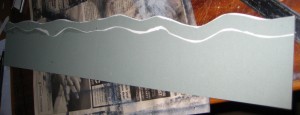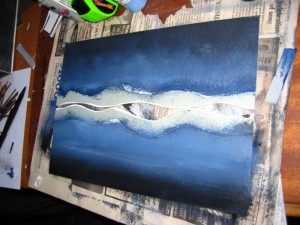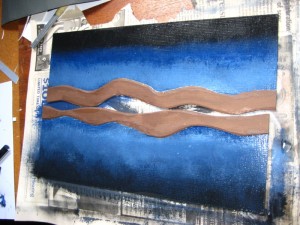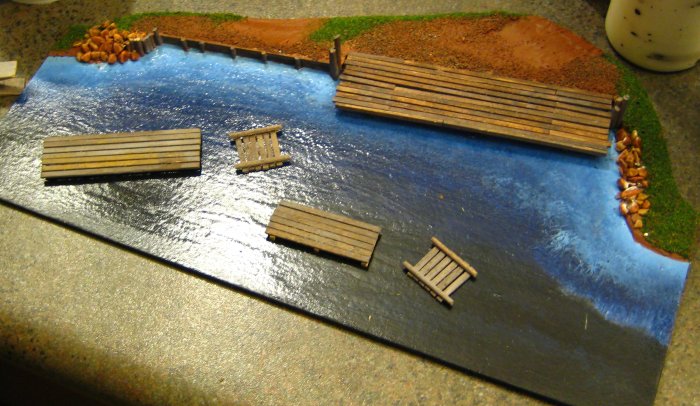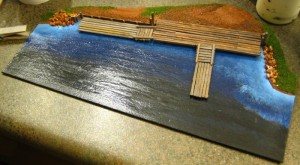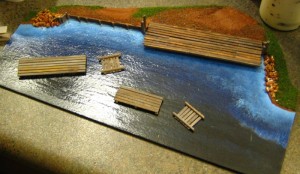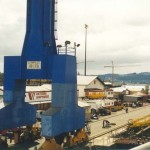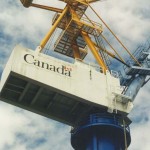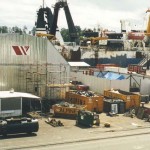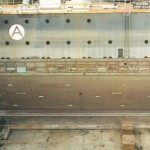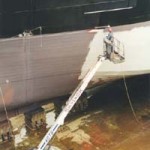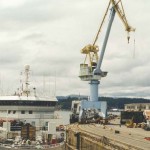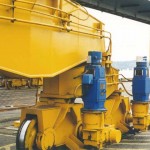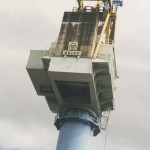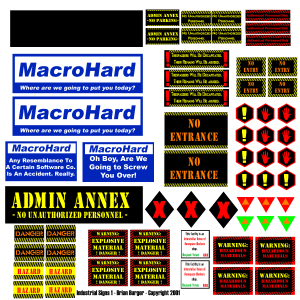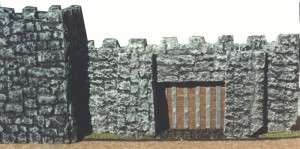Found, buried in my harddrive, another couple of forgotten work-in-progress shots from the first round of shoreline/riverbank construction back in June 2009. The rest of the construction was written up last week.
Tag Archives: terrain
Shoreline or River Bank Terrain Pieces
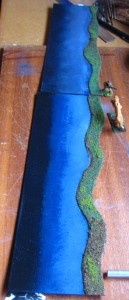
These riverbanks or shorelines made from picture-framing board (mattboard). I did the first set back in 2009 and another batch in the winter of 2010. They’re designed to form one edge of a playing board, especially on the 2’x2′ playing areas common to .45 Adventures. One of the really nice things about games like 45A that encourage smaller playing areas is that terrain projects become a whole lot more managable — no more having to crank out eight feet of river just to have enough to be usable on the table!
Each segment is 12″ (1 foot) long and 5″ deep, 4″ of river and 1″ of banks. The banks are the same mattboard as the rest, to keep them as low-profile as possible. The painting is black and two colours of blue, damp-blended right on the card. I tried to keep the edges mostly matched while painting the pieces. The water portions then got about six or so coats of acrylic gloss varnish so they looked like water. If I was going to paint them again, I’d do the water areas a greener shade with less black, as is often seen in murky jungle rivers.
In the winter of 2010 I added two new segments to the set, one another copy of the existing riverbank pieces, and the second incorporating a ramshackle wooden dock. The dock segment was wider than the others for most of the length, although obviously the same width at the ends. The docks were built up with baswood planks, with toothpicsk and bamboo skewers for the piilings. The large dock section is glued to the base; the three smaller sections are freestanding for flexibility.
All four sections have been largely free of warping or damage, although the docks section does havea tendency to bow when stored. The eventual plan is to rebuild these riverbank sections in 2mm or 3mm MDF, using a bandsaw to cut the curves, but mattboard will do until then!
(these photos have been seen over on the Lead Adventure Forum and elsewhere previously, if you’re thinking they look a bit familiar…)
Gallery: Shipyard Photos for Inspiration
Another revival from the old Brian’s Wargame Pages version of the site, and one that I should have brought forward ages ago! You can see the Esquimalt Drydock on Google Maps for a sense of scale that wasn’t available ten years ago when I first posted the photos. — Brian, 22 Feb 2011
In the summer of 2001 I was roommates with a guy who worked in the drydock here in town. He turned into a real asshole after being laid off, but while he was still working he gave me a tour of the yard. I brought my camera, and these pics should inspire people looking for new industrial modern or SF scenery projects!
One thing that would be very difficult to reproduce on the gaming table, except maybe in 6mm, would be the sheer scale of the place. I didn’t have my wide-angle lens with me, so I didn’t even try for some real area photos. The drydock itself is 1100 feet long; the two big cranes pictured below are several hundred feet tall. There were two fair-sized ships in the drydock when I was there, and they could have accomodated a third with no difficulty. And this isn’t even that big a drydock, by maritime engineering standards. The ones that can accomodate nuclear-powered aircraft carriers are even bigger…
Wargamers interested in industrial scenery or future-tech industrial landscapes (Necromunda style) should find plenty of inspiration here! Even if you can’t reproduce the scale, the clutter, details and fixtures should provide some ideas.
Click any image below for a (slightly) larger view. Keep in mind these are refugees from the Old Web, when 600px wide was a Big Image.
Sci-fi Signage
Note: These signs are Brian’s work from the old Warbard. One day they may be recreated in Inkscape and SVG — Corey
This zip file contains two very detailed, 1200dpi images in Adobe Photoshop PSD format, with lots of varied industrial & safety signs to decorate your industrial scenery and buildings.
Each image is roughly 3×3 inches. Print onto standard paper – or the lightest paper your printer can handle – and cut out and glue onto your scenery. A few of these on a nice piece of industrial machinery or factory wall really make a piece ‘pop’ – after all, real industrial sites tend to be plastered with signs, notices and warnings. (The actual images are MUCH more detailed than the little sample image here!)
As usual, these are free to download, print or modify for personal use.
Update, 8 Aug 2020: I’ve just confirmed that these old (from sometime in 2001!) PSD files can be opened just fine in the current version of GIMP. Not bad for files nearly twenty years old!
Dirt Roads from Caulking
A graphic tutorial I whomped up for the heck of it, as usual in the incomparable Inkscape.
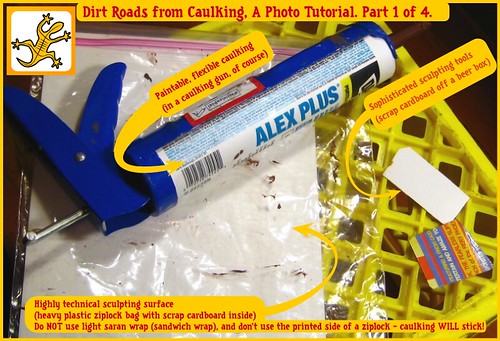
15mm castle
Mesa we will see you again?
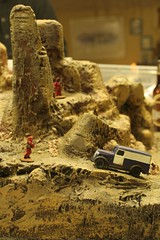 Large terrain pieces are the lifeblood of any good gaming table and in a fit of boredom late one night at my old job (after my work was done for the day, honest), I set out to create such a piece.
Large terrain pieces are the lifeblood of any good gaming table and in a fit of boredom late one night at my old job (after my work was done for the day, honest), I set out to create such a piece.
Enter the mesa. Like many such projects, there was absolutely no prior design, just some scribblings on a pad before I set off to construct it. I knew I wanted a stone arch with a pathway up and over for characters to fight on, and I wanted a winding road up to a plateau, but everything else came as I hacked and sawed.
Palm Trees
I think I’ll have to try this – I have a few plastic palm trees, but more is never a bad thing: Pipe cleaner palm trees (via MiniatureWargaming.com)
Repainting Commercial Stone Walls
Pegasus produce a range of prepainted plastic 28mm wargaming scenery; all the stuff I’ve seen has been well cast but mostly badly painted. The stone wall sections are good value for money, though, with six 6″ sections for $10 at my Friendly Local Gaming Store.
I picked up a pack, took them home and while repainting them, took enough photos to assemble into a quick, hopefully inspirational, how-to.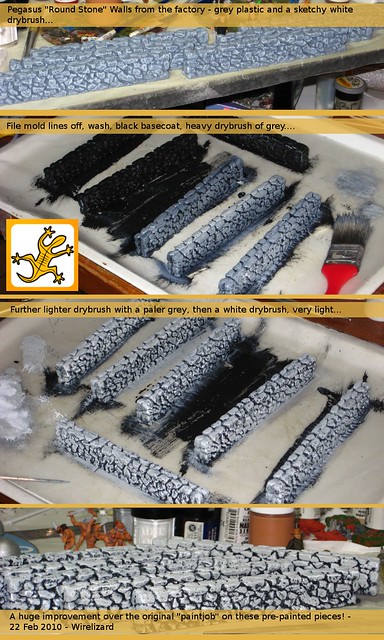
(Click the image to see the full-size version at Flickr)
Building A 28mm Tent
There’s been previous versions of this tutorial posted on Lead Adventure and the Speakeasy, but I figured it’s worth reposting here.
After killing a dress shirt (black ink leaking does that to white cotton) I realized it would work nicely as material for a large safari/expedition tent. I used a CD as the base, with small blobs of milliput holding long toothpicks vertically as the poles — three on the front, three on the back. After the putty holding the poles was dry (and reinforced with a bit of superglue) I wrapped thick sewing thread around the tips of the poles, with a dab of superglue holding it in place and a bit more superglue stiffening the thread after it was secured.
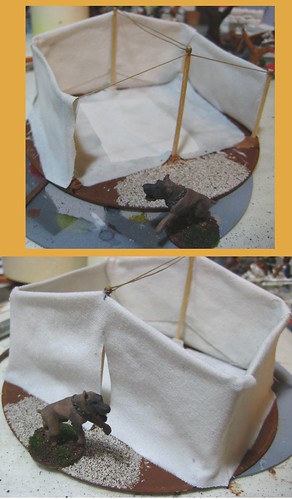
(click through to Flickr for a full-size image)
The fabric was cut twice as tall as it needed to be, and draped over the thread at the tops of each wall, with a generous layer of white glue on the inside of each piece. The walls were folded over, squeezed together and held whilst drying by clothspegs.
Two layers of shirt-weight cotton plus white glue makes for very solid walls!
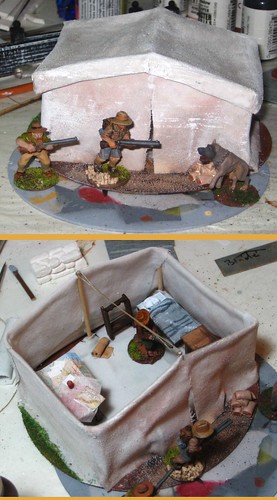
(click through to Flickr for a full-size image)
The removable roof was made by first draping a piece of plastic wrap over the tent walls, then carefully folding and pinning the piece of glue-soaked cotton into position. I folded the eves up and trimmed them after the first coat of glue was dry, and it fits well; between the glue and the folding it’s more than rigid enough to hold it’s shape.
There’s an extra piece of cotton to form the floor, and most of the interior furniture is made of offcuts of basswood and styrene, with putty for the blanket and pillow. The maps were found on the internet, shrunk to appropriate tiny sizes, and printed out. The red coffee mug in the centre of the large map is a scrap of round styrene.
I’ve still got a good sized piece of this shirt; eventually more of it will live again as smaller tents to accompany this one. Recycling — it doesn’t just involve a blue bin, you know. Not for wargamers, anyway!

